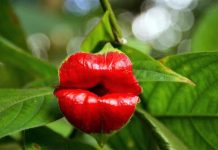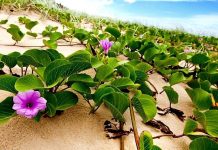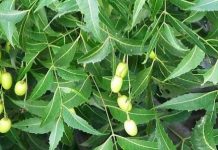Family: Capparaceae
Synonym:Crateva magna (Lour.) DC.
Bengali/Vernacular name: Barun, Bannay, Tikoshak, Bonna, Gotaburna, Ladung, Tikthashak (Bengali); Haniboruna (Noakhali).
Tribal name: Pitagola (Chakma), Buron (Hajong), Jong-sia (Garo), La pova (Marma), Kaingtha (Mogh), Laa-khaw-bawn (Rakhaing), Senatuk (Tripura).
English name: Three leaved caper.
Description of the plant: A small to medium-sized dieciduous tree, up to 15 m high. Leaves clustered at the ends of the branchlets, with a common petiole 5-10 cm long, at the summit of which are three leaflets. Leaflets ovate-lanceolate or ovate, 7.5-12 cm long, 4-6 cm wide, pointed at the base, a rather slender point at the tip. Corymbs terminal, many-flowered, rachis 10-15 cm long.Flowers creamy, polygamous. Fruit a berry, 2-6 cm in diameter, oblong-ellipsoid or oblong-ovate, pericarp woody, yellowish-grey, with powdery crest. Seeds dark brown, embeded in creamy pulp.
Plant parts used: Leaf, bark, root.
Herbal uses: Decoction prepared from leaves of the plant is taken thrice a day (20 ml amount each time) for three weeks to treat asthma.
Bark sap is used as a cure for tympanites, and convulsions.
Paste prepared from the leaves of the plant is applied to the swelling places, at the same time leaf juice is taken twice a day to treat gout.
Fresh juice extracted from the roots of the plant is given thrice a day (10 ml amount each time) until the jaundice is cured.
Paste prepared from the leaves of the plant is applied after warming to the affected part of the body once a day for three days to treat lipoma (tumour).
Decoction of bark is used for the treatment of urinary calculi, and various urinary disorders.
Fresh juice extracted from the leaves of the plant is taken twice a day (two tea spoons amount each time) for seven days to treat piles.
The plant is used for the treatment of bronchitis, pneumonia, tonsillitis, eczema, abscess, acne, scabies, scars, warts, dysentery, constipation, stomachache, headache, and toothache.
Distribution: The species occurs throughout Bangladesh on river bank, canal banks, and low-laying areas.
Is this plant misidentified? If yes, please tell us….















